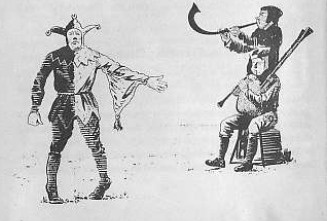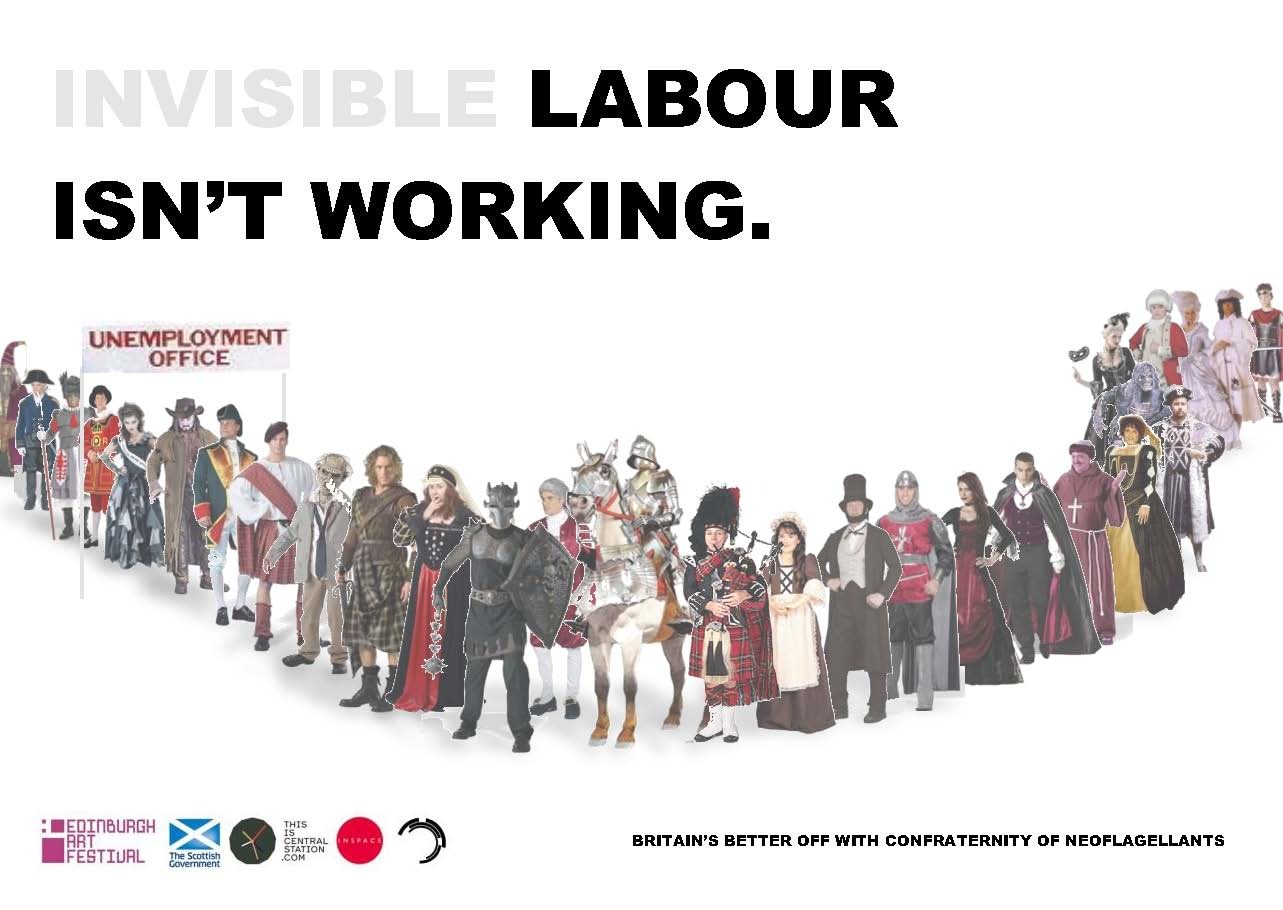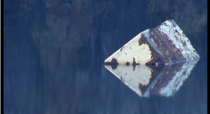
Image: Anthony Kerris and Jane Walmsey – Maelstrom
Neil Mulholland, one half of the collaboration which established the Confraternity of the Neoflagellants, talks to Central Station about the fascinating themes behind the group’s event taking place at this year’s Edinburgh Art Festival.
‘The Confraternity of Neoflagellants’ – it’s quite a name, how would you describe this collaboration to the uninitiated?
The Confraternity of Neoflagellants was founded in 2009 by Serjeant-At-Law Norman Hogg (then of The Embassy) and joined by Keeper of the Wardrobe Neil Mulholland (Edinburgh College of Art). It is a secular and equal opportunities confraternity bound by chirograph.
Well sort of. There has to be a myth of origin. Norman came up with the name and invited Neil to join him (Norman was the founding member). Norman set up a Facebook group and then we gradually invited new members that we wanted to work with. Most of the neoflagellants recruited to date were in ‘Avalon’ or wrote for it. There are more now. It’s based on medieval fraternities which are similar to itinerant social groups you find online and in cosmopolitan cities today. We are seeking to recruit other members to our crusade as well as find new disciples as we establish a wider Confraternity. We are transdisciplinary in this sense, we will wander to where we find something of interest and work in whatever way is suitable. For example, this is why we are working with Central Station – an archconfraternity – that mirrors the guild system as it was manifested during the development of the early world economy (c.1250-1350). The Confraternity of Neoflagellants is a Trojan for scholarly, hermeneutic and creative reflection upon what Central Station is, where it comes from and where it might go. Central Station is one lens through which this activity is filtered – a portal that makes our process visible and which enables the benefice to function at increasingly great distances of space and time.
‘neoflagellants’ because we are lay peoples dedicated to the ascetic application, dissemination and treatment of neomedievalism in contemporary culture. It’s a multiple name that allows people to come and go – in this sense it’s drawing on iconoclastic collectives like neoism and ‘pataphysics. We’re influenced by the ways in which the medieval concept of the commons is being re-established online, often in quite utopian ways (i.e. Folkmote / creative commons). It’s also prevalent in International Relations and related discussions of globalisation (a much more interesting way of seeing this than by looking at corporatism). This needs to impact upon art practice, the way that things are produced in technoculture seems far more exciting and open right now. There’s the sense of working on a production being more like making a film, that it might involve lots of people and morph during the process of coming together as everyone plays their part. We want to avoid auteurism and lose control of what we’re doing. So flagellants in the sense of inflicting unnecessary pain upon ourselves perhaps! The Confraternity of Neoflagellants doesn’t have to include Neil or Norm or anybody that’s been involved to date. It’s not a group like The Beatles and it’s not a collective either. It’s just a sensibility, a dynamic one at that. It can be taken on by anyone who wants to develop any of the ideas we’re working with (they aren’t our ideas after all, they belong to everyone).

Image: designed by Robby Ogilvie
Tell me more about the event you’ll be hosting at the Edinburgh Art Festival.
It’s called An Unco Site!, a line from Burns’ ‘Tam O’Shanter’. We changed the spelling of the line sight to site. (so it now reads something like ‘magnificent place’ in translation to English) We wanted to enact a spectacle in the form that Tam sees it and to relate this to the social production of place right now here in Edinburgh. We didn’t want to do too much to create this, the ghosts that Tam sees are ordinary in a sense, they are having a break from spooking people – they are relaxing after their work. It’s their leisure time. Our intention is to haunt an area of Edinburgh that is yet to transform into a place, a space that seeks to combine work and play. The walk we have planned is casual yet oddly transtemporal engagement with these spaces. The glass curtain wall of the reception venue is a physical boundary signifying history’s much-debated alterity. Overall the proceedings will combine psychogeography, micro-history and canonical mysticism with festival tourism to create a rich dialogue between all involved. It will engage the audience with the relationship between sight and site. Key to this is engaging with the invisible, in particular with itinerant service sector labour and the new quarters of the city that are yet to be inhabited.
There has been an escalation of this kind of work since the numerous heritage re-enactments that were part of Homecoming Scotland last year (our recruitment poster INVISIBLE LABOUR ISN’T WORKING refers to this, and has a nod to the ‘airbrushed-asian’ debacle). These workers are a particularly interesting example of post-industrial labourers, part of what Pine and Gilmore call The Experience Economy (Harvard Business School Press, Boston, 1999). Herein lies the analogy with Edinburgh’s new towns, business and leisure areas that are attempting to generate a cosmopolitanism in harsh economic conditions. These neomodernist are a tabula rasa surrounded by the loaded Medievalisms, Victoriana and Georgian planning. Haunting a new building is intended to provide it with a phastasmic heritage, a pre-modern consciousness, a psychogeographical palimpsest of the kind of inhabitation that it is yet to enjoy. The analogy between post-plague medieval economic meltdown and zombie capitalism is quintessentially neomedieval as is the connection between today’s flash mobs and urban folk devils such as the infamous Edinburgh Mob of the Old Town.
Ricardo Marini will be one of the speakers at our symposium. He’s a very interesting planner from Edinburgh City Council (City Design Leader). We hope to investigate what’s happening with the city with him in more depth.
An Unco Site! is in three parts. Firstly there will be a flash mob and ghost walk through Edinburgh. We meet at the Scott Monument at 11pm on the 7th of August. We have a publicity campaign running at the moment that will be seen around Edinburgh in the run up to the Festival opening – INVISIBLE LABOUR ISN’T WORKING. It features lots of the sorts of ‘ghosts’ we’d like to see traipsing the cobbles on the 7th, including Peter Sellers and the cast of Rentaghost! We are attempting to recruit as many costumed actors and historical tour guides from the streets of Edinburgh as possible.
Secondly, once we have enough people gathered on the 7th, we will then walk to a secret location where an after party will be held featuring music from Paul Vickers & The Leg and Adopted as Holograph. There will also be a DJ set and some Vjing too. There will be free drinks at the party (until they run out). To get in all you need to do is dress appropriately, either as an historical figure or as a ghost and turn up at the Scott Monument on the 7th at 11pm. ‘Death’ will be on the door of the reception and will decide whether or not you get to pass over the Styx.
Thirdly we are holding a symposium on the 9th of August at Inspace in Edinburgh. This will feature:
Dr Mark Jardine (Scottish Historian, University of Edinburgh and author of BBC’s History of Scotland series)
Yann Chateigné (Head of Visual Arts, Geneve University of Art & Design)
Riccardo Marini (City Design Leader, City of Edinburgh Council)
Neil Cooper (Critic and Journalist, The Herald)
Keynote:
Howard Rheinhold (www.rheingold.com)
Updates on what’s happening, including the location of the venue (announced at 10:45pm on the 7th of August) are available here: lightmotiv.org.uk
Neomedievalism is at the core of the project – where did your interest in this stem from? How do you see this theme manifested in the event?
There is a history to the long now that we’re working with. Neomedievalism embraces the spectral traces or ‘uncertain knowledges’ of its historical past as part of an ever-morphing, force-feedback simulation, (or permanent rehearsal) of coming events. The longing for a future assembled from a bricolage of pre-modern components embeds itself deeper with every advance in the technologies of representation. The fantasy must become ever closer to reality. The scholastic symbolism of Dante Alighieri’s Commedia – the principle map of dualistic medieval cosmology and a mythology important to the hacker intelligentsia of early Internet development communities – codifies the ecclesiastical space we are working in according to neomedieval gaming principles of grinding and leveling-up common in the ‘beige age of swords and circuitry’, the nerdosphere of MUD’s and MMORPG.
We will be speaking with world wide web pioneer and online guru Howard Rheingold about this in our symposium on the 9th of August in Inspace.
How do you want people to get involved?
We want people to get dressed up and walk through the city with us then enjoy the reception afterwards. If they aren’t sure what to wear, we have a few fancy dress shop sponsors in Edinburgh that will give you a discount on a hire if you mention An Unco Site! (see lightmotivorg.uk for more info). If they are also around on Monday the 9th then they are more than welcome to come along to our symposium – it’s open to all.
If someone really wants to perform or speak at An Unco Site! then they should contact us directly at info@confraternityofneoflagellants.org.uk
What role will Central Station be having?
Hopefully it will snare us a few ghosts and play host to some images captured by participants in the event. We are working with the filmmaker Matt Brown to make sure that all of An Unco Site! will be recorded and made available on Central Station and at our page confraternityofneoflagellants.org.uk in the form of a short film. We are also hoping to have live video feeds running into Central Station, fingers crossed with that…
And finally… what other events are you most looking forward to at Edinburgh Art Festival this year?
Kim Coleman & Jenny Hogarth, Big Things on the Beach, Martin Creed, William Wegman, Hito Steyerl and Twonkey’s Cottage.
Find out more about the events taking place at Edinburgh Art Festival here.














Comments